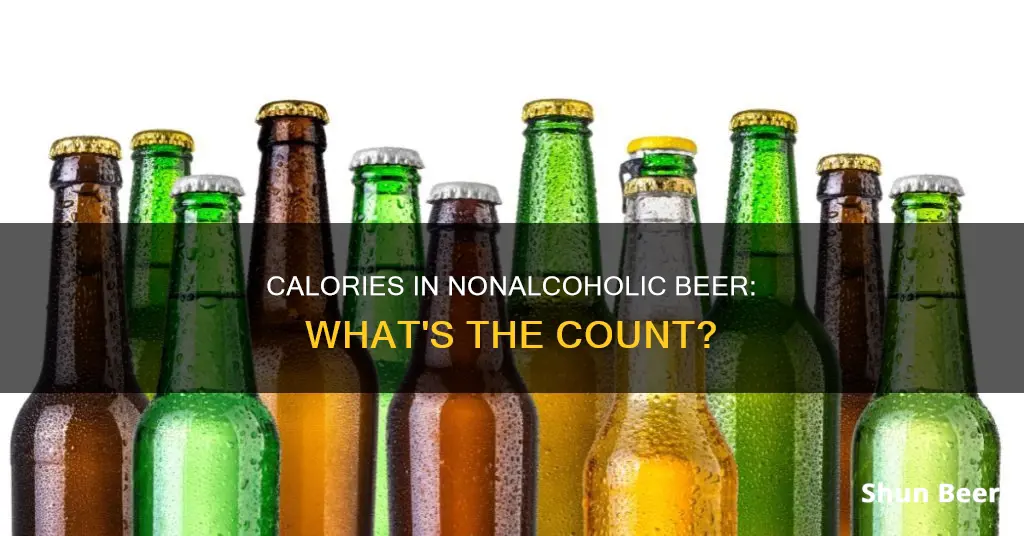
Non-alcoholic beer has become increasingly popular in recent years, with sales rising 39% in 2019 and 38% in 2020. But how does it compare to regular beer in terms of calorie content?
Well, it's complicated. Non-alcoholic beers can range from as few as 17 calories to 80 or 90 calories per bottle or can. By comparison, regular beers typically fall in the 140 to 170-calorie range, with light beers containing 95-120 calories. So, at first glance, it might seem like non-alcoholic beers are the clear winner when it comes to calorie count.
However, it's important to note that non-alcoholic beers tend to have more carbohydrates and sugar than regular beers. This is because they contain added sugar to improve the flavour after the alcohol has been removed. So, while non-alcoholic beers may have fewer calories, they can still have a significant impact on your waistline.
In conclusion, while non-alcoholic beers can be a good option for those looking to reduce their alcohol intake, they may not be the best choice for those counting calories.
Characteristics and Values of Non-Alcoholic Beer
| Characteristics | Values |
|---|---|
| Calories | 17-99 calories per serving |
| Carbohydrates | 2-22g per serving |
| Protein | Nearly zero |
| Alcohol Content | Up to 0.5% alcohol by volume (ABV) |
| Vitamins | Contains small amounts of B vitamins |
What You'll Learn

Non-alcoholic beer has a similar calorie count to light beer
Non-alcoholic beer typically contains more sugar than regular beer, which can result in a similar number of calories. For example, a 330ml bottle of Carlsberg (3.8%) has 122 calories, whereas a 330ml bottle of Carlsberg "0.0" (0%) has 73 calories. Similarly, a cup of standard malt non-alcoholic beer contains 99 calories, while light beers typically contain 95-120 calories.
However, it is important to note that the calorie content of non-alcoholic beers can vary significantly, ranging from as few as 17 calories to 80 or 90 calories. For instance, a 12-ounce serving of Heineken 0.0 contains 63 calories, while a 12-ounce bottle of St. Pauli Girl Non-Alcoholic Beer has 96 calories.
Additionally, non-alcoholic beers tend to have more carbohydrates than regular beers. For example, Coors Non-Alcoholic has 58 calories but carries 12.2 grams of carbs. This is because non-alcoholic beers often contain added sugar to improve their flavour. As a result, they can contain more than twice as many carbohydrates as alcoholic beers, which significantly increases their calorie content.
Therefore, while non-alcoholic beer may have a similar calorie count to light beer, it is important to read the nutrition labels as the calorie and carbohydrate content can vary among different brands and types of non-alcoholic beers.
Calorie Counting: Beer-Battered Onion Rings
You may want to see also

Non-alcoholic beer is not a health drink
Non-alcoholic beer is often marketed as a healthier alternative to alcoholic beer. While it's true that non-alcoholic beer contains less alcohol, it's important to remember that it's not necessarily a health drink. Here are some reasons why:
Calories and Carbohydrates:
Non-alcoholic beer tends to have a similar calorie count as light beer. While some newer brands contain fewer calories and carbs, many non-alcoholic beers have just as many calories as regular beer due to their added sugar content. So, if you're looking to reduce your calorie intake, non-alcoholic beer may not be the best option.
Alcohol Content:
Non-alcoholic beers can legally contain up to 0.5% alcohol by volume (ABV) in the US. While this is a small amount, it's important to note that some non-alcoholic beers may contain more alcohol than their labels indicate. Additionally, for certain populations, such as pregnant women and those recovering from alcoholism, even small amounts of alcohol can be harmful.
Lack of Nutritional Value:
Non-alcoholic beers offer very little nutritional value and are mostly carbohydrates. While they may contain small amounts of vitamins and minerals, these are also present in regular beer. So, in terms of nutritional benefits, non-alcoholic beer doesn't offer much more than its alcoholic counterpart.
Potential Health Risks:
Non-alcoholic beers are not completely free of health risks. For example, they can trigger cravings and relapses in people recovering from alcohol use disorder. The smell and taste of non-alcoholic beer may be similar enough to regular beer to induce cravings and potentially lead to a relapse. Additionally, non-alcoholic beer should be avoided during pregnancy, as even small amounts of alcohol can lead to birth defects and other complications.
Cost:
Non-alcoholic beer tends to be more expensive than regular beer. A six-pack of non-alcoholic craft beer can cost at least $10, while there are more affordable alternatives to achieve hydration and replace electrolytes, such as chocolate milk.
In conclusion, while non-alcoholic beer can be a good option for those looking to reduce their alcohol intake, it's not necessarily a healthy choice. It's important to be aware of the potential risks and limitations of non-alcoholic beer and to make an informed decision about its consumption.
Calorie Count in Dos Equis Amber Beer
You may want to see also

Non-alcoholic beer may improve sleep
Non-alcoholic beer typically contains a similar number of calories to regular beer, due to its added sugar content. A cup of standard malt non-alcoholic beer contains 99 calories, and 19.1 grams of carbohydrates. However, some non-alcoholic beers contain fewer calories and carbs than alcoholic beers, with some containing as few as 17 calories per can.
How Non-Alcoholic Beer May Improve Sleep
Non-alcoholic beer may help you fall asleep faster and improve your quality of sleep. A study conducted in Spain evaluated the sleep of 17 nurses over the course of three weeks. During the first week, the participants drank their usual pre-bed beverage, and during the following two weeks, they drank one non-alcoholic beer. The results showed that the participants fell asleep an average of 12 minutes faster and had less disturbed sleep. They also reported feeling less anxious.
The sedative effect of non-alcoholic beer is likely due to the presence of hops, which act as a sedative by raising the neurotransmitter gamma-aminobutyric acid (GABA) and soothing the central nervous system. Hops also affect serotonin, a neurotransmitter involved in sleep regulation and the body's circadian rhythms.
It is important to note that while non-alcoholic beer may improve sleep, it still contains calories and carbohydrates, and should be consumed in moderation. Additionally, non-alcoholic beer often contains small amounts of alcohol, and should be avoided by pregnant women and individuals recovering from alcoholism.
Samuel Adams Beer: Calorie Count and Nutrition Facts
You may want to see also

Non-alcoholic beer may reduce appetite
Non-alcoholic beer is a great option for those looking to cut down on their alcohol intake without compromising on taste. But is it a good option for those looking to reduce their calorie intake too?
Non-Alcoholic Beer and Calories
Non-alcoholic beer is made by removing the alcohol from regular beer. Despite having a much lower alcohol content, non-alcoholic beer contains a similar number of calories to regular beer. This is because non-alcoholic beer contains more than twice the carbohydrates, mostly in the form of added sugar, which helps to improve the taste.
Non-Alcoholic Beer and Appetite
Non-alcoholic beer is not a good option for those looking to reduce their calorie intake, but could it help to reduce appetite?
Alcohol is a toxin, so any way to limit the amount of alcohol in your body is a healthier choice. Non-alcoholic beer does exactly that, by satisfying your taste buds without the buzz. Anecdotal evidence suggests that switching from beer to non-alcoholic beer may help improve any alcohol-related sleep issues. A 2018 study found that just two drinks per day for men and one drink per day for women decreased sleep quality by 24%.
Drinking alcohol can also impact ghrelin production, a hormone that stimulates appetite and food intake. This may explain why drinking alcohol can give you late-night munchies. Therefore, drinking non-alcoholic beer may help to reduce your appetite, as it satisfies your taste buds without impacting your ghrelin production.
Non-Alcoholic Beer and Pregnancy
It's important to note that non-alcoholic beer isn't always completely alcohol-free. In the US, non-alcoholic beer can legally contain up to 0.5% alcohol, and some non-alcoholic beers contain up to 2% ABV. As such, non-alcoholic beer should be avoided during pregnancy, as even small amounts of alcohol can lead to pregnancy complications.
Calories in Oktoberfest Beer: What You Need to Know
You may want to see also

Non-alcoholic beer is not a good post-workout drink
Non-alcoholic beer is often marketed as a healthier alternative to regular beer, but is it a good post-workout drink? The short answer is no. While non-alcoholic beer has its benefits, there are better options for post-workout hydration and recovery.
First, let's look at the calorie content of non-alcoholic beer. Contrary to what some may believe, non-alcoholic beer is not necessarily low in calories. In fact, it often has a similar calorie count to light beer, ranging from about 60 to 120 calories per serving. This is because non-alcoholic beers tend to have more sugar than regular beer, which is added to improve the taste after the alcohol has been removed. The sugar contributes to the calorie count, making non-alcoholic beer unsuitable for those watching their calorie intake or following a low-carbohydrate diet.
In addition to the calorie content, the lack of significant electrolytes in non-alcoholic beer makes it less than ideal for post-workout hydration. While it's true that non-alcoholic beer can provide some carbohydrates for energy, it generally doesn't contain enough electrolytes like magnesium, potassium, and sodium, which are important for rehydration and replenishing lost nutrients after a workout.
Another reason why non-alcoholic beer may not be the best post-workout drink is that it can still contain trace amounts of alcohol. The U.S. Food and Drug Administration allows non-alcoholic beers to contain up to 0.5% alcohol by volume. While this amount is significantly less than regular beer, it's important to note that it can still be present, especially for those who are avoiding alcohol completely.
So, what are some better alternatives for post-workout drinks? Nutritionists recommend options that provide carbohydrates, protein, and electrolytes for optimal recovery. Chocolate milk, for example, has carbohydrates, sugar, and fat, providing a good balance of nutrients to replenish energy stores after a workout. Sports drinks are also a good option, as they help replenish carbohydrates and provide electrolytes, which are crucial for rehydration.
In conclusion, while non-alcoholic beer can be a great alternative to regular beer for those looking to reduce their alcohol intake, it is not the best choice for a post-workout drink. It is important to consider the calorie content, lack of significant electrolytes, and the presence of trace amounts of alcohol when making an informed decision about post-workout hydration and recovery options.
Cheese Soup Calories: Beer's Influence on Fitness Goals
You may want to see also
Frequently asked questions
Non-alcoholic beer has a similar calorie count to light beer. A cup of standard malt non-alcoholic beer contains 99 calories. However, the number of calories in non-alcoholic beer varies and can range from as few as 17 calories to 80 or 90 calories.
Non-alcoholic beer generally has fewer calories than alcoholic beer. For example, a 330ml bottle of Carlsberg (3.8%) has 122 calories, whereas a 330ml bottle of Carlsberg "0.0" (0%) has 73 calories.
Although non-alcoholic beer has little to no alcohol, it often contains added sugar to improve the taste. This added sugar increases the calorie content.
Yes, there are non-alcoholic beers with low calories. For example, Surreal Brewing Company's Natural Bridges Kolsch Style has 17 calories, and Athletic Brewing Co's Lite has 25 calories.







